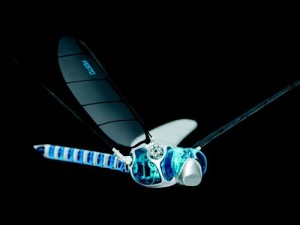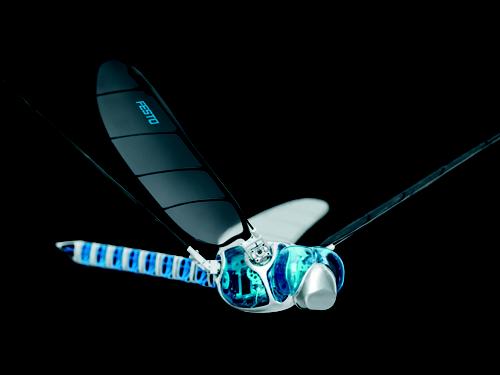
Festo, inventor of sophisticated and elegant robotic birds, as well as robot jellyfish and penguins, has done it again. The company’s latest robotic achievement is a dragonfly, the BionicOpter, which can independently move each of its wings to fly in any direction.
Introduced at the Hannover Trade Fair in Germany this week, the BionicOpter is one of many projects the company has pursued under the aegis of its Bionic Learning Network. The network’s purpose is to use the energy-efficient principles already found in nature and adapt them to automation technology.
The robotic dragonfly can speed up or slow down quickly, or even fly backwards, because of its ability to independently move each of its four wings. It can also float like a glider while holding its wings steady. Since it doesn’t need to generate forward thrust by tilting forward, the BionicOpter can also fly horizontally. It’s extremely lightweight at 175 gm (6.17 oz). Its body, made of flexible polyamide and terpolymer, is 44 cm (17.3 inches) long, and houses an ARM microcontroller, eight servo motors for wing actuation, a brushless motor, two 7.6V lithium polymer batteries, 2.4 GHz wireless modules, and inertia, acceleration, and position sensors.
The head and body are actuated by four flexible muscles made of nitinol, a shape memory alloy (SMA) that expands when cooled and contracts when heated. An electrical current passing through these “muscles” makes them move the tail up and down and the head from side to side. Each of the BionicOpter’s carbon fiber-framed wings are covered with a thin foil material, and total wingspan is 63 cm (24.8 inches). Direction and intensity of each wing can be individually adjusted: The direction of each wing’s thrust is determined by its swiveling motions, and its amplitude controller regulates the intensity of that thrust.
Each wing’s flapping frequency and twisting motions are also independently controlled, and data on wing position and twisting is recorded and evaluated while the dragonfly is in flight. Remote-controlled with a smartphone, the robot only needs its operator for steering and speed control. Software and electronics coordinate the robot’s motions.
Before attempting the complexities of engineering the robot dragonfly, Festo developed its SmartBird, which can take off, and fly and land autonomously, rising by means of its flapping wings alone. Inspired by a herring gull, the robotic bird flies, glides, and sails. A complex flight control system in its torso and tail section, combined with its articulated torsional drive unit, lets SmartBird’s wings twist at specific angles, as well as beat up and down to optimize airflow use without the requirement for additional devices to assist lift. The bird’s wing position and torsion are monitored by ZigBee-based two-way radio communication, which conveys operating data such as battery charge and power consumption, as well as pilot input.
Although Festo’s press release claims that the BionicOpter dragonfly robot is the first system that can perform all the flight maneuvers of a plane, a helicopter, and a glider, two of these abilities have previously been demonstrated in one machine by Japan’s Ministry of Defense. The Japanese remote-controlled flying spherical robot can move in any direction, fly down narrow passageways or up and down stairways, and take off and land vertically anywhere, on surfaces of nearly any shape. Like a helicopter, it can hover for eight minutes continuously, but the orb also has wings that let it fly forward horizontally at up to 60 km/hour.
Source: http://www.designnews.com/author.asp?section_id=1386&doc_id=261885&itc=dn_analysis_element&



